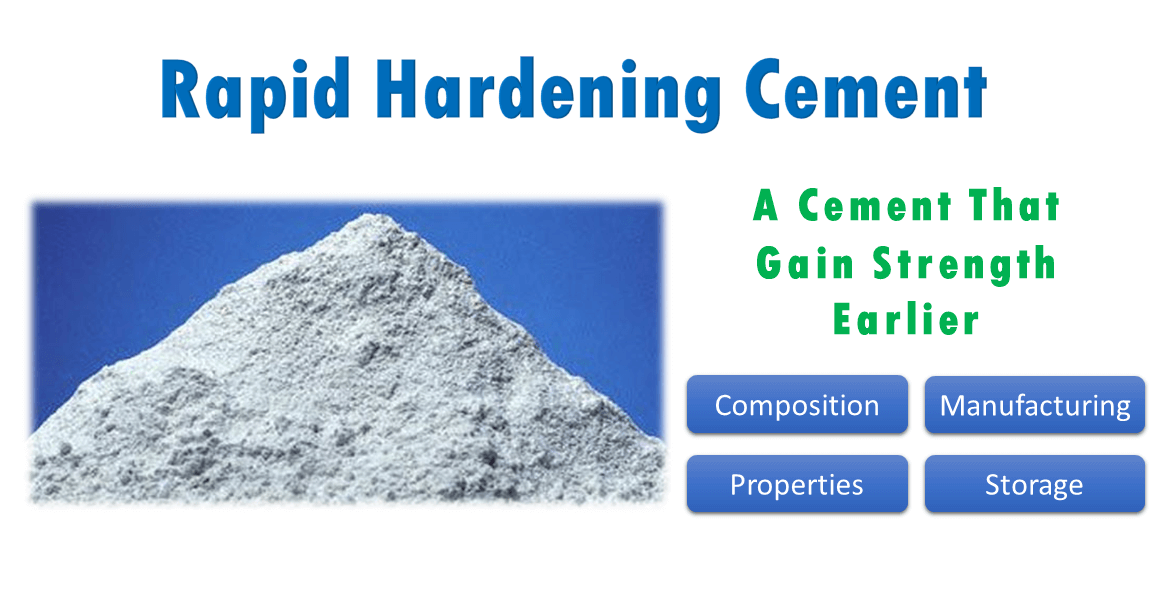In various construction projects, It is often required to gain early strength of concrete. Changing the cement type can do the trick. To meet this purpose rapid hardening cement could be used.
This article solely focuses on different aspects of Rapid hardening cement- its properties, composition, manufacturing, storage, etc. We also have the following two articles on rapid hardening cement.
What is Rapid Hardening Cement?
Rapid Hardening Cement (RHC) is a certain type of Portland cement typically used in concrete construction to develop high strength earlier than Ordinary Portland Cement (OPC).

According to AASHTO M 85 specification and ASTM C 150 standard specification for Portland cement, RHC is a type-III cement also called High Early Strength cement. It is different from quick-setting cement which only sets earlier but hardens at the same rate as OPC. As this cement achieves the same strength in 3 days which takes OPC 7 days to attain provided the same water-cement ratio has been used, it is called rapid hardening1.
Composition of Rapid Hardening Cement
If we analyze the ingredients of cement, we can see cement is a mixture of calcareous (calcite), siliceous (silicate), argillaceous(Clay), and other substances. Generally, Rapid Hardening Cement contains the following ingredient proportions.
- 60% Tricalcium silicate (C3S),
- 15% Dicalcium silicate (C2S),
- 10% Tricalcium aluminate (C3A) and
- 8% Tetracalcium aluminoferrite of the total weight of cement.
OPC contains 50% C3S of its total weight. So it is observed that Rapid Hardening Cement composition contains a higher percentage of C3S than OPC.
{adselite}
Manufacturing of Rapid Hardening Cement
The following are the stages of rapid hardening cement manufacturing process.
Mixing
To manufacture RHC, the dry process is used in mixing the aforementioned raw materials. Firstly, the materials are crushed and converted into small size pieces. Then they are dried in drying kilns typically keeping the quantity of water under 1%. Then again, the dried materials are ground in a ball mill to turn them into fine particles.
Burning and Grinding
After mixing the materials in appropriate proportions, the mixture is burned at a high temperature. Here the chemicals go through some reactions and are turned into calcium silicates which form the cement clinker. The cooled pellets are then ground in ball mills or tube mills and during this grinding process, a small proportion of gypsum is added. In cement, gypsum acts as a retarder.
The dry process of cement manufacture is more economical as less heating is required. This is how RHC is manufactured in bulk.
Properties of Rapid Hardening Cement
Despite its similarities with OPC, RHC has some significant features. This variation from typical physical & chemical properties of cement is why RHC is becoming more popular.
Strength
Rapid hardening cement attains double strength than that of OPC cement in the first 24 hours. Reasons RHC develops strength rapidly are-
- This cement contains a higher amount of C3S than OPC. C3S helps hydration and hardening process to happen quickly. So this chemical affects the initial set and development of early high strength.
- Cement clinkers are grounded in a finer (min 3250 cm2/gm) manner than OPC(2250 cm2/gm) causing an increase in surface area of cement particles2. This provides a better rate of hydration so the cement gains early strength.
- C3A also accelerates the process of hydration and hardening. It causes a high amount of heat emission.
In 3 days RHC develops the same amount of strength that OPC develops in 7 days for the same water-cement ratio.
Fineness
Rapid hardening cement clinkers are grounded in a finer (min 3250 cm2/gm) manner than OPC(2250 cm2/gm).
Setting Time
Initial setting time = not less than 30 mins. Within this period, solidification begins.
Final setting time = not more than 600 mins. During this time, the mixture attains sufficient hardness.
Weight
RHC is lighter than OPC.
Resistance
RHC has higher resistance against chemical attacks like sulfate.
Curing Time
RHC requires less curing time than OPC as it develops strength rapidly.
Heat of Hydration
RHC releases enormous amounts of heat during the setting. Because it undergoes rapid hydration reactions for its finer grind and high C3S content.
Storage of Rapid Hardening Cement
Cement storage in field conditions is a great matter of concern. Rapid hardening cement should be kept in a dry and cool place. Otherwise, moisture can damage its texture and ability easily by causing untimely hydration and carbonation reactions.
Reference
- Building Construction-By B.C. Punmia; Ashok Kumar Jain; Arun Kumar Jain.
- Civil Engineering Materials-By TTTI Chandigarh.

